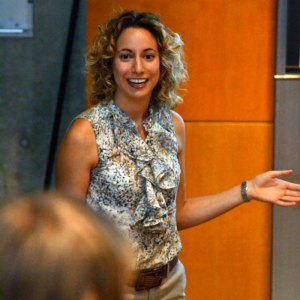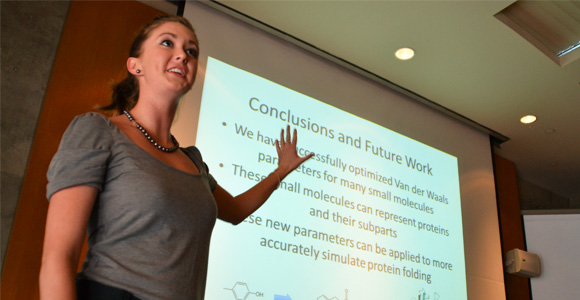The classrooms of the W. M. Keck Science Department transformed into a scientific symposium September 7 when more than 60 students from Scripps, Pitzer, and Claremont McKenna presented original summer research to their peers and professors. Varying in scope and topic, the scientific presentations gave the Claremont Colleges community a glimpse of the biology, chemistry, and physics research conducted by undergraduates, many of whom were recipients of the Mellon Environmental Analysis Fellowship or were awarded a Norris Foundation grants.
Continue reading to learn more about projects by Scripps College students.
Dail Chapman ‘13
A biophysics major, Dail Chapman (above) studied how to better simulate protein folding. For 10 weeks this summer, she worked with visiting assistant professor of physics Paul Nerenberg on research simulations, and she is writing about her methodology and research findings for tentative publication in an academic journal.
“Proteins start as a string of amino acids and fold into a functional structure by interactions between non-bonded amino acid side groups. In order to simulate protein folding, it is important to accurately simulate these non-bonded interactions. Non-bonded interactions depend on Van der Waals parameters, and these were what we were hoping to optimize. So, our results were a set of optimized Van der Waals parameters, which will help better simulate protein folding,” she says. “These values could be applied to other research projects studying protein folding.”
Kopano Ramsay ‘14
Kopano Ramsay, a chemical engineering major, worked with associate professor of chemistry Kathleen Purvis-Roberts to examine amine particles – which are a component of pollutant matter – on a dairy farm in Hanford, Calif. She chose to examine a dairy farm because places of animal husbandry have the highest concentration of amines. At the symposium, Kopano discussed how amine concentrations in the air affect weather conditions.
“Research is interesting because I like finding out things that aren’t known,” says Kopano, who chose to do summer research at Keck to find out whether she truly wants to be a research scientist after college.
Anna Silverman ‘13
 While at Scripps College, Anna has worked on clinical research at the Mayo Clinic. Her thesis, which she worked on with an eye surgeon, explores the current assumption that patients treated for glaucoma and who are allergic to sulfa antibiotics should not be prescribed a carbonic anhydrase inhibitor (CAI) for fear of triggering an allergic reaction. Carbonic anhydrase inhibitors are a sulfa-based medication used to stabilize intraoccular pressure in glaucoma patients.
While at Scripps College, Anna has worked on clinical research at the Mayo Clinic. Her thesis, which she worked on with an eye surgeon, explores the current assumption that patients treated for glaucoma and who are allergic to sulfa antibiotics should not be prescribed a carbonic anhydrase inhibitor (CAI) for fear of triggering an allergic reaction. Carbonic anhydrase inhibitors are a sulfa-based medication used to stabilize intraoccular pressure in glaucoma patients.
“Preliminary analysis suggests that many sulfa-allergic patients can safely benefit from oral carbonic anhydrase inhibitors,” says Anna, a W. M. Keck Fund grant recipient. “It is exciting to be involved in a project that may influence future decisions of medical professionals.”
Jessica Baker ‘13
Jessica Baker conducted research on juvenile Black Phoebe birds for her senior thesis in biology. The project, which was funded by a Norris Foundation grant and supervised by visiting assistant professor of biology Elise Ferree, tracked how the birds learned to forage like adults.
The research gave Jessica invaluable field experience and improved her understanding of a bird’s natural life cycle and development. “Researching banded juvenile Black Phoebes enabled me to observe an individual bird’s skill and personality development over the course of two months. This research will add to the literature on the life cycle of Black Phoebes and their age-specific growth, which is valuable to understand due to the increasing urban settlement patterns of this species,” said Jessica.
Margaret Nurimba ’14
Margaret, a molecular biology major, researched and determined which genes networks are important for the fission yeast‘s response to the manmade environmental toxins of BPA, BHA and BHT. Margaret will continue her research in anticipation of her senior thesis. Current research suggests that gene networks known to correlate to DNA damage and cell wall integrity are especially important in the organism’s overall response to the toxins.
Margaret’s research was made possible by a Mellon Environmental Analysis Fellowship. She worked under the supervision of associate professor of biology Irene Tang. “Doing this type of research under an environmental analysis perspective has given me a different way to analyze biochemical research and its results, and has shown that these types of collaborations are extremely important in advancing new technologies, both for the good of the environment and science,” Margaret says.
Kelsey Mesa ’13
Kelsey, a senior chemistry major, examined the synthesis of a thiophosphoramide ligand for gold catalysis, which carries important implications for the pharmaceutical industry. Chemistry professor Anna Wenzel serves as her thesis advisor. Kelsey’s research is useful in pharmaceuticals because chirality is often a determination of toxicity.
Thiophosphoramides contain a phosphorus atom bonded to a nitrogen and an amino group. Carbon groups of this molecule can be tailored to create a chiral catalysis. “The catalyst in this situation is used to teach a product how to be chiral by blocking a reactive side of a starting material,” Kelsey says. A chiral molecule has a non-superimposable mirror image. “This is like your right hand versus your left,” Kelsey says. “In terms of chemistry, the ‘left’ versus the ‘right’ can have different effects in drug production.”
The W.M. Keck Science Department is the interdisciplinary home to all biology, chemistry, and physics faculty for Claremont McKenna, Pitzer, and Scripps Colleges. The department is administered cooperatively and is housed within an 81,000-square-foot Center, located at the intersection of the three colleges. The department offers 13 discrete degree options, including dual-degree programs in partnership with schools of engineering and majors in conjunction with disciplines outside the sciences. The W.M. Keck Science Department provides comprehensive, interdisciplinary instruction in small class settings and numerous opportunities for students to conduct research. Our graduates enter a significant range of careers and enjoy acceptance into prestigious graduate research and health science programs.


